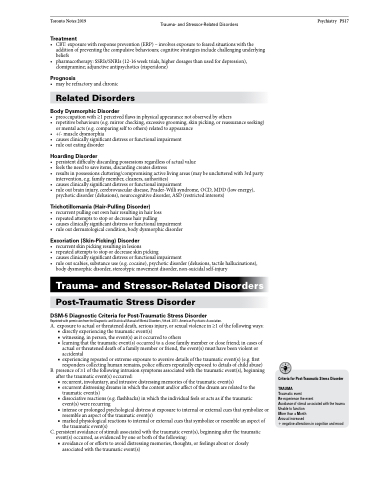Page 1181 - TNFlipTest
P. 1181
Toronto Notes 2019 Trauma- and Stressor-Related Disorders
Treatment
• CBT: exposure with response prevention (ERP) – involves exposure to feared situations with the addition of preventing the compulsive behaviours; cognitive strategies include challenging underlying beliefs
• pharmacotherapy: SSRIs/SNRIs (12-16 week trials, higher dosages than used for depression), clomipramine; adjunctive antipsychotics (risperidone)
Prognosis
• may be refractory and chronic
Related Disorders
Body Dysmorphic Disorder
• preoccupation with ≥1 perceived flaws in physical appearance not observed by others
• repetitive behaviours (e.g. mirror checking, excessive grooming, skin picking, or reassurance seeking)
or mental acts (e.g. comparing self to others) related to appearance • +/- muscle dysmorphia
• causes clinically significant distress or functional impairment
• rule out eating disorder
Hoarding Disorder
• persistent difficulty discarding possessions regardless of actual value
• feels the need to save items, discarding creates distress
• results in possessions cluttering/compromising active living areas (may be uncluttered with 3rd party
intervention, e.g. family member, cleaners, authorities)
• causes clinically significant distress or functional impairment
• rule out brain injury, cerebrovascular disease, Prader-Willi syndrome, OCD, MDD (low energy),
psychotic disorder (delusions), neurocognitive disorder, ASD (restricted interests)
Trichotillomania (Hair-Pulling Disorder)
• recurrent pulling out own hair resulting in hair loss
• repeated attempts to stop or decrease hair pulling
• causes clinically significant distress or functional impairment • rule out dermatological condition, body dysmorphic disorder
Excoriation (Skin-Picking) Disorder
• recurrent skin picking resulting in lesions
• repeated attempts to stop or decrease skin picking
• causes clinically significant distress or functional impairment
• rule out scabies, substance use (e.g. cocaine), psychotic disorder (delusions, tactile hallucinations),
body dysmorphic disorder, stereotypic movement disorder, non-suicidal self-injury
Trauma- and Stressor-Related Disorders
Post-Traumatic Stress Disorder
DSM-5 Diagnostic Criteria for Post-Traumatic Stress Disorder
Reprinted with permission from the Diagnostic and Statistical Manual of Mental Disorders, 5th ed. 2013. American Psychiatric Association.
A. exposure to actual or threatened death, serious injury, or sexual violence in ≥1 of the following ways: ■ directly experiencing the traumatic event(s)
■ witnessing, in person, the event(s) as it occurred to others
■ learning that the traumatic event(s) occurred to a close family member or close friend; in cases of
actual or threatened death of a family member or friend, the event(s) must have been violent or
accidental
■ experiencing repeated or extreme exposure to aversive details of the traumatic event(s) (e.g. first
responders collecting human remains, police officers repeatedly exposed to details of child abuse) B. presence of ≥1 of the following intrusion symptoms associated with the traumatic event(s), beginning
after the traumatic event(s) occurred:
■ recurrent, involuntary, and intrusive distressing memories of the traumatic event(s)
■ ercurrent distressing dreams in which the content and/or affect of the dream are related to the
traumatic event(s)
■ dissociative reactions (e.g. flashbacks) in which the individual feels or acts as if the traumatic
event(s) were recurring
■ intense or prolonged psychological distress at exposure to internal or external cues that symbolize or
resemble an aspect of the traumatic event(s)
■ marked physiological reactions to internal or external cues that symbolize or resemble an aspect of
the traumatic event(s)
C. persistent avoidance of stimuli associated with the traumatic event(s), beginning after the traumatic
event(s) occurred, as evidenced by one or both of the following:
■ avoidance of or efforts to avoid distressing memories, thoughts, or feelings about or closely
Psychiatry PS17
associated with the traumatic event(s)
Criteria for Post-Traumatic Stress Disorder
TRAUMA
Traumatic event
Re-experience the event
Avoidance of stimuli associated with the trauma Unable to function
More than a Month
Arousal increased
+ negative alterations in cognition and mood


